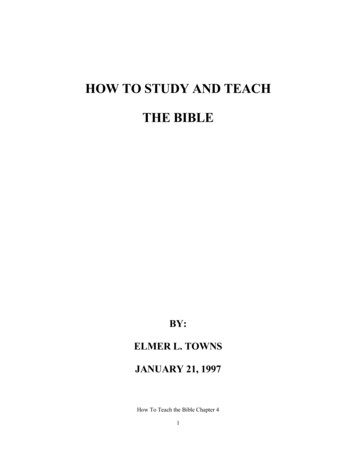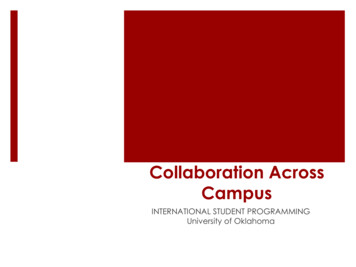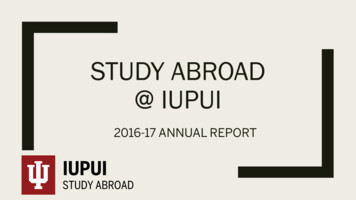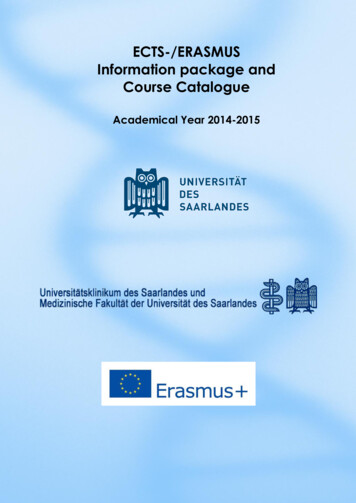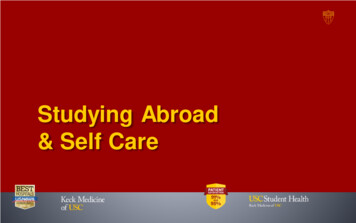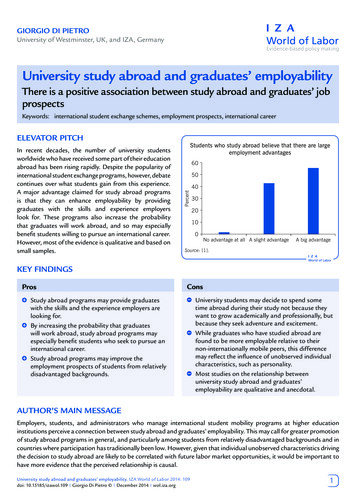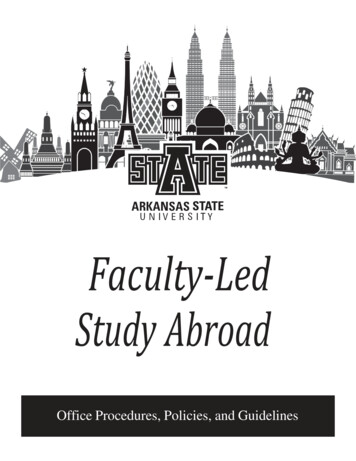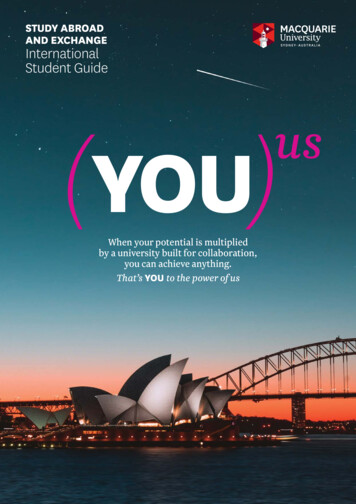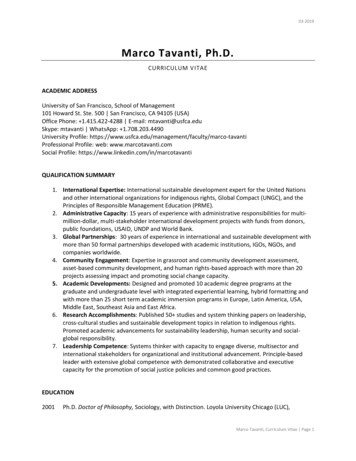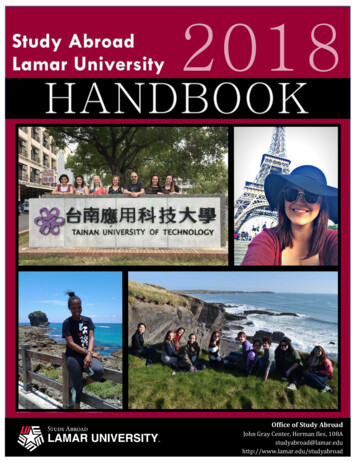
Transcription
studying and trainingabroadstudentguidebook
Strengthening theTraining Opportunitiesfor InteRnational YouthPRIMEProblems of Recognitionin Making ErasmusCopyright 2015 by the Erasmus Student Network AISBL. All rights reserved.Studying and Training Abroad: Student GuidebookEditor in Chief: Margarida CarvalhoEditors: Brikena Xhomaqi, Stefan Jahnke, Emanuel Alfranseder, Jesús Escrivá Munõz,Safi Sabuni, Gaffar RampageProofread by: Nives Tomaš and Andrea BusuttilPublished by: Erasmus Student Network AISBLDesign by Piotr MonsiorskiPhotos: Patrick Doodt, Markus Lutter, Jirka Matoušek, Dejan ŽagarEdition: August 2015This guidebook cannot be sold and it is distributed freely by the Erasmus StudentNetwork AISBL.For ordering copies of the publication, please contact secretariat@esn.org or write to:Erasmus Student Network AISBLRue Hydraulique 151210 Brussels, BelgiumTel: 32 2 256 7427A free electronic version of this report is available atesn.org/studentguidebookwww.esn.org
DEAR STUDENTTaking part in an Erasmus exchange can be one of the greatest experiencesin a student’s academic career. Erasmus is an academic exchange that offersa great added value to your curriculum. It complements the academicknowledge gained with opportunities for personal development andhelps students to acquire skills needed for today’s job market. That’snot all! Erasmus also means discovering and exploring new cultures,meeting new people, learning new languages and travelling. If you havefriends that are former Erasmus students, you have probably heardabout how great of an experience a period abroad during your studiescan be and what it can give in return.Going abroad for a period of your studies might seem scary at first. Thefears of getting lost in bureaucratic processes or not being able to obtainthe full academic recognition are some of the main reasons why studentsdon’t go abroad. The Erasmus programme offers a wide range of differentpossibilities to go abroad, whether it is for one semester, two semesters,a traineeship, volunteering or a full degree. However, having knowledgeof all these possibilities may be difficult. This is why we have preparedthis short guidebook for you!The Student Guidebook is a brief, yet comprehensive compendium,showing you the recognition process, step-by-step. It will explain youthe different opportunities and give you guidance on what and when youneed to prepare before, during and after your mobility period. Moreover,it will explain your rights and obligations as an Erasmus student and helpyou ensure that you make the most out of your Erasmus experience!Enjoy the reading,Safi Sabuni,President, Erasmus Student Network AISBL 2015-16
Table ofcontentsErasmus in a nutshellYour rights and obligationsWho is WhoA few documents to knowErasmus Mobility Erasmus Mobility for studies Erasmus Mobility for traineeshipsMobility for post graduates Erasmus Mundus Joint Master Degrees Marie Skłodowska-Curie Actions fordoctoral candidates Erasmus for Young Entrepreneurs European Voluntary ServiceMeeting your local ESN section!6812151822303435363738
Erasmus in aNUTSHELLThe Erasmus programme (European Region Action Scheme for theMobility of University Students) was established in 1987. It has developedinto one of the most successful projects of the European Union andnowadays offers a range of different possibilities for you under the newprogramme called Erasmus . It enables students to study and workabroad. Currently, there is the possibility to study in one of the 33programme countries for a certain period of time (from 2 to 12 months,depending on the type of mobility). From 2015, students are able tostudy in partner countries (outside of Europe) and from 2016 it will alsobe possible to carry out traineeships in those countries.You can take advantage of the different mobility opportunities for upto 12 month for each of the following cycles of your higher educationstudies: During the first study cycle (Bachelor or equivalent)including short-cycles During the second study cycle (Master or equivalent) During the third cycle as Doctoral CandidateStudent mobility forms an important part of the European Union’sErasmus programme. To participate you need to be studying in anErasmus programme country and your Higher Education institutionneeds to have signed the Erasmus Charter for Higher EducationInstitutions (ECHE).6
You can find a list of Higher Education Institutions with the ErasmusCharter for Higher Education Institutions on the website from theEducation, Audiovisual and Culture Executive Agency (EACEA):esn.org/HEIsErasmus offers the following opportunities for you to go abroad duringyour studies:1. Erasmus Mobility for Studies2. Erasmus Mobility for Traineeships3. Mobility for post graduatesBy 2013, Over 3 million students had participated in the Erasmusprogramme It was present in more than 4,000 Higher EducationInstitutions in Europe Annually, around 250,000 students pack their bags and moveabroad to spend part of their studies in a foreign country.ERASMUS StudiesTraineeshipPost Graduate7
Your rights andOBLIGATIONSHigher Education Institutions (HEIs) that want to participate in theErasmus programme must possess an Erasmus Charter for HigherEducation (ECHE). The Charter aims to guarantee the quality of theprogramme by setting certain fundamental principles. Moreover, bysigning the Erasmus Charter for Higher Education, HEIs agrees to givefull recognition to students who satisfactorily complete the activitiesspecified in the compulsory Learning Agreement.The right to obtain full recognition is also written in the Erasmus Student Charter.Both the ECHE and the Erasmus Student Charter are available onthe Erasmus website and it should also be available on your HigherEducation Institution website.Erasmus Student CharterThis Student Charter highlights your rights and obligations and informsyou about what you can expect from your sending and receivingorganisation at each step of your mobility.Higher education institutions participating in Erasmus have beenawarded an Erasmus Charter for Higher Education by the EuropeanCommission where they commit to support, facilitate and recogniseyour mobility activities. On your side, you commit to respect the rulesand obligations of the Erasmus grant agreement that you have signedwith your sending institution.8
I. Before your mobility period Once you have been selected as Erasmus student, you are entitledto guidance regarding the partner institutions or enterprises whereyou can carry out your mobility period and the activities that youcan undertake there. You have the right to receive information on the distribution ofgrades at the receiving institution and to receive information insecuring a visa, obtaining insurance and finding housing by your sendingand receiving institution/enterprise. You can find the respectivecontacts points and information sources in the inter-institutionalagreement signed between your sending and receiving institutions. You will sign a Grant Agreement with your sending institution (evenif you do not receive a financial support from EU funds), and a LearningAgreement with your sending and receiving institution/enterprise.A good preparation of your Learning Agreement is key for thesuccess of your mobility experience and to ensure recognition ofyour mobility period. It sets out the details of your planned activitiesabroad (including the credits to be earned and that will count towardsyour home degree). After you have been selected, you will undertake an online language assessment (if available in your main language of instruction/work abroad) that will allow your sending institution to offer you themost appropriate linguistic support, if necessary. You should take fulladvantage of this support to improve your language skills to therecommended level.9
II. During your mobility period You should take full advantage of all the learning opportunitiesavailable at the receiving institution/enterprise, while respectingits rules and regulations, and endeavour to perform to the best ofyour ability in all relevant examinations or other forms of assessment. You can request changes to the Learning Agreement only inexceptional situations and within the deadline decided by yoursending and receiving institutions. In that case, you must ensurethat these changes are validated by both the sending and receivinginstitutions/enterprise within a two-week period after the requestand keep copies of their approval by e-mail. Changes due to anextension of the duration of the mobility period should be made astimely as possible as well. Your receiving institution/enterprise commits to treat you in thesame way as their home students/employees and you should makeall necessary efforts to integrate in your new environment. Your receiving institution will not ask you to pay fees for tuition,registration, examinations, access to laboratory and library facilitiesduring your mobility period. Nevertheless, you may be charged smallfees on the same basis as local students for costs such as insurance, studentunions and the use of miscellaneous material. You are invited to take part in associations existing at your receiving institution/enterprise, such as networks of mentors and buddiesorganised by student organisations such as Erasmus Student Network. Your student grant or student loan from your home country mustbe maintained while you are abroad.If you have a problem, at any time: You should identify the problem clearly and check your rights and obligationsaccording to your grant agreement. Several people work in your sending and receiving institutions to help Erasmus10students. Depending on the nature of the problem and when it occurs, thecontact person at your sending or receiving institution (or receiving enterprisein case of a traineeship) will be able to help you. Their names and contactdetails are specified in your Learning Agreement.
III. After your mobility period You are entitled to receive full academic recognition from your sendinginstitution for satisfactorily completed activities during your mobilityperiod, in accordance with the Learning Agreement. If you are studying abroad, your receiving institution will give youa Transcript of Records recording your results with the credits andgrades achieved (normally in less than five weeks after the end ofyour evaluation). Upon reception of this document, your sendinginstitution will provide you all the information on their recognition ina maximum period of five weeks. The recognised components (forexample, courses) will appear in your Diploma Supplement. If you are doing a traineeship, your host enterprise will give youa Traineeship Certificate summarising the tasks carried out and anevaluation and, when it was foreseen in your learning agreement,your sending institution will also give you a Transcript of Records.If the traineeship was not part of the curriculum, the period will atleast be recorded in your Diploma Supplement and, if you wish, inyour Europass Mobility Document. If you are a recent graduate youare encouraged to request the Europass Mobility Document. You should undergo an online language assessment, if available inyour main language of instruction/work abroad, to monitor linguisticprogress during your mobility. You must fill in a questionnaire to provide feedback on your Erasmusmobility period to your sending and receiving institution, the NationalAgency of the sending and receiving country and the EuropeanCommission. If you face unjustified problems with recognition, use the formal appealprocedures in your sending institution if necessary. If your sending or receiving institution fails to fulfil the obligations outlinedin the Erasmus Charter for Higher Education or in your grant agreement,you can contact the related National Agency. Feel free to also turn to your student associations, such as Erasmus StudentNetwork, to seek help from students whom work to represent internationalstudents every year.11
WHO IS WHOThere are several people and institutions working on the Erasmus programme. You will cooperate with them during your application,preparations, stay abroad and formalities upon return, and therefore itis important to know who is responsible for what.International Relations Office (IRO)Both your sending and receiving institutions have an InternationalRelations Office. They can have different names, e.g. InternationalBureau or Exchange Office. Their role is to provide information andcounselling for incoming and outgoing students. The IRO stafftakescare of all official documentation and the enrolment process at bothinstitutions. They are also a provider of information about the applicationprocedure, requirements and the practical arrangements related to yourstay abroad.Erasmus CoordinatorUsually, each Higher Education Institution has one institutional Erasmuscoordinator and one Erasmus coordinator per faculty. The list of thecoordinators can be found on the institution’s website. The coordinatorsare responsible for advising students on their choice of courses andthe number of ECTS credits needed. In case of any problems, you canconsult the coordinator at either your sending or receiving institution.12
National Agency (NA)The National Agency is the link between the European Commissionand the Higher Education Institutions in your country. National Agencies are responsible for the promotion and implementationof the Erasmus programme on the national level and are thereforefamiliar with the relevant issues and organisational structures. Youcan consult your National Agency if you need information aboutthe Erasmus programme. Also, if your institution is failing to fulfiltheir obligations concerning the Erasmus Charter for HigherEducation (ECHE) you can report the problem to your National Agency.Find a list of National Agencies here:esn.org/NAsErasmus Student NetworkErasmus Student Network (ESN) is the biggest network of studentassociation in Europe. It was born on the 16th October 1989 with the aimof supporting and developing student exchange. Through the principlesof Students Helping Students, ESN works to improve the social andpractical integration of international students, and to represent theneeds and right of those students on local, national and internationallevel.ESN involves around of 34.000 volunteers offering services to around190.000 international students every year. ESN is present in more than500 Higher education institutions in 37 countries. To find your closestESN Section, go to:esn.org13
A few documentsTO KNOWLearning agreementThe Learning Agreement is a negotiated agreement between you, yoursending and your receiving institution and has to be signed prior to yourmobility period.You will sign a Grant Agreement with your sending institution, even ifyou do not receive any financial support from EU funds, and you will alsohave to sign a Learning agreement with your sending and receivinginstitutions.The Learning Agreement for Erasmus Mobility for Studies includeswhat modules you will be studying during your period abroad, howmany ECTS are allocated to those courses and your required languagecompetences.The Learning Agreement for Erasmus Mobility for Traineeships doesnot only indicate the programme of the traineeship and the knowledgeand skills to be acquired by the trainee but it also states whether thetraineeship is part of your curriculum or if it is a voluntary traineeshipand, depending on that, how it will be recognised. In addition, it informswhether it awards ECTS (and how many) and if it is recorded in theDiploma Supplement.14
Once your application to go on Erasmus Mobility is approved, allparties need to sign the Learning Agreement: For studies: student, sending institution, receiving institution For traineeship: student, sending institution, enterprise/organisationLearning AgreementStudentSending InstitutionReceiving Institution/ enterprise / organisation15
ECTSThe European Credit Transfer and Accumulation System (ECTS) wasdeveloped by the European Commission as a tool for the transfer ofstudents’ achievements in Erasmus student mobility, thus allowingthe transfer of learning experiences and outcomes between differentinstitutions.ECTS is adopted as the national credit system in most countries ofthe European Higher Education Area. In other regions, it is increasinglyused by institutions or interacts successfully with local credit systems.ECTS credits are based on the estimated workload necessary for thestudent to achieve the defined learning outcomes. Each course component(lectures, trainings, seminars etc.) has an allocated number of credits.The workload of a full academic year is translated into 60 credits.Transcript of RecordThe Transcript of Records is an official document that provides the proofof your study achievements, thus allowing recognition. It gathers theeducational components you have taken abroad, the number of ECTScredits you have achieved and the grades you have been awarded.The receiving institution should send the Transcript of Records to yoursending institution at the end of your period of study in order to formallycertify the work completed, the credits awarded, and the local gradesreceived during the mobility period.This document will show all courses that were originally presented inthe Learning Agreement and if they were successfully completed ornot. Your sending institution is obliged to recognise and integrate allparts of the signed Learning Agreement into your curriculum.The format of the transcript of records may be different from institutionto institution.16
17
ERASMUS MOBILITYGoing on Erasmus means that you will spend part of your studies andtraineeship abroad. It is not an additional semester or two; it is fullyintegrated into your pre-existing curriculum. To benefit fully from theErasmus exchange and to obtain full recognition upon return, youneed to prepare your stay in advance.When to go abroadThis is the first decision you need to take. You can take this decisionas early as one or two years in advance. If you take a careful look atthe programme of your studies you will notice that there are differentcourses: mandatory major courses; mandatory minor courses; freeelectives; thesis and so on. Each study programme has a certain numberof mandatory courses you will need to complete to obtain your degreeand a certain number of free electives to choose from.Most probably you will have a mixture of free electives and mandatorycourses each semester. If you want to go on exchange, it is better tochoose a semester or academic year where you will have less mandatorysubjects and more free electives. This will give you more flexibility inchoosing courses at your receiving institution. If you are not sure what thebest time for you to go on Erasmus will be, ask your Erasmus coordinatorfor advice.18
ScholarshipWhen you are going abroad through the Erasmus programme you areeligible to receive an Erasmus grant to assist you with the additionalexpenditure that you have when living abroad. The amount of the grantis different for studies and traineeships and depends on the destinationcountry.This grant is only intended to support your period abroad. You shouldnot rely on it for essential living expenses such as food and rent. Ifyou are a student with disabilities you have the possibility to receivesupplementary Erasmus funding.In addition, you may be able to claim a retrospective travel grant afteryour period abroad. Note that you will need to submit your bookingconfirmation and all receipts as part of the application.To find out more about the amount of financial support you can expect getin touch with your International Relations Office at your sending Institution.Language Assessment and Linguistic SupportIn your Learning Agreement you have agreed on a level of languagecompetence which you already have or you will acquire by the start ofthe mobility period. To assess whether you have already reached thislevel of language competence you will have to conduct a compulsorylanguage assessment. The language assessment will be in the languageof your host country or the language in which your courses will betaught. The language assessment will be provided after your selectionand will not determine whether you are accepted to a mobility period ornot. Currently, the language assessment is only available in the following 6 languages: English, French, Spanish, Italian, German and Dutch.More languages will be added during the academic year 2015/2016,therefore we encourage you to remain in contact with your International Relations Office to find out whether other languages have beenadded.19
After undertaking the online language assessment you will be offered anOnline Linguistic Support course (OLS) in accordance to your languagelevel. The levels are measured through the common European Frameworkof Reference (CEFR) with the grading from level A1-C2. The OLS isan interactive language platforms that offers you the opportunity tolearn the language while you are studying abroad. You should take fulladvantage of this support to improve your language skills, find moreinformation about the OLS on http://erasmusplusols.eu/At the end of your mobility you will be asked to make another languageassessment to map out how much your language skills have improvedduring your mobility. You will be sent a reminder 30 days after yourmobility period finishes.Online feedback surveyYou must also fill in an online questionnaire to provide feedback onyour Erasmus mobility period within 30 days after it finishes. If you donot fill it you might have to pay back your grant or parts of it.20
21
Erasmus Mobility forSTUDIESHow to Apply? Check the deadline for applications of your sending institutionand the eligibility criteria.Each Higher Education Institution has its own deadline for applications.You should start your preparations by checking all of the deadlines.This is really important, because there are usually only one or twotime frames when you can submit your application for going onErasmus Mobility for studies each year. Choose the institution where you want to go on exchangeThings to remember when choosing the institution where you willbe studying abroad:0 Check the list of institutions you can go to. You can do yourErasmus Mobility for studies in any institution that has anagreement with your own institution. This information should beavailable on the website of the institution or your faculty. If youcannot find it, consult the International Relations Office or askthe Erasmus Coordinator of your university.0 Check the programme for the semester at your sending institution– see what the mandatory subjects are and how many free electivesyou have.0 Check the study programme in the potential receiving institutionsand see if they have comparable learning outcomes.22
Apply at your sending institutionEach HEI has its own application procedure. Sometimes you willhave to submit your CV and motivation letter, in other cases youwill have to present yourself in front of a special commission to bechosen. Most countries also require a language test or a proof ofyour language capabilities in form of a certificate. In all cases, makesure you are well prepared! Prepare the necessary documentsThe Erasmus programme will allow you to transfer your learningoutcomes from the receiving institution to your sending institution,but to complete this process successfully you will need to prepare andsubmit several documents before, during and after your exchange.Checkthe deadlineChooseUniversityApplyPreparedocuments23
Before your mobility periodplanyourSTUDIESHow to choose courses in your Learning Agreement?The learning agreement has to be signed prior to the study periodabroad and includes what courses you will be studying during yourperiod abroad.To complete the Learning Agreement, you need to choose a range ofcourses. It is very important that you choose the courses that suityou best, in order to benefit most from the exchange and to get themrecognised when you come back. Start by looking at the programme atyour sending institution for the semester you want to go abroad. Youshould find courses (or other components) that will allow you to learnsomething that is comparable with what you would have learnt if youfollowed other components from your home degree. They do not haveto match, but they have to be comparable as a group.Afterwards you will have to visit each professor that is teaching oneof the obligatory courses to make sure they agree with your selection.This step is crucial to avoid problems with recognition when you returnfrom your studies abroad.Pay attention to the schedule of the courses at the receiving university.Usually Erasmus students are allowed to choose from a variety ofcourses from different years, subject and faculties. Therefore, it mighthappen that some of the courses you would like to take will overlap.To avoid this situation and future changes in the Learning Agreement,make sure you check the timetables before you make a final decisionupon the courses.Before going abroad make sure to understand what happens in caseyou do not pass all courses at the receiving institution. Consult withyour International Relations Office before going abroad. Each Institutionhas different regulations.24
TIPCheck if you have enough ECTS in your Learning AgreementMost institutions that apply ECTS publish their course catalogues witha description of credits for each of their courses. As some institutionsuse different scales to measure the workload of a course you will needto ask the institution how to transfer them into credits.Most institutions use ECTS, which is the recommended credit transfersystem. However, a range of institutions still uses ECTS together witha national system of credit calculation. You need to check if your universityis using ECTS only, or combines it with its own system. In the lattersituation, your ECTS credits will be transferred and re-calculated. Askthe person responsible for the credit transfer to support you with theconversion from the national system into ECTS. Make sure that youhave enough credits after the conversion.TIPAsk about the system of grade transfer at your institutionThe grading systems vary greatly at different Higher Education Institutionsin Europe. It is really important that the transfer of grades is transparent,as sometimes grants or other benefits may depend on your level ofperformance during the exchange. Inform yourself sufficiently about thegrade conversion to not run into problems after returning back home.Ask your Erasmus coordinator to provide you with the conversiontable and to explain it thoroughly.TIPCollect the necessary signatures for your Learning AgreementAs every contract it will only be valid if you have all the signatures required.You need the following signatures:a) Your own signatureb) Signature of the responsible person at the sending institutionc) Signature of the responsible person at the receiving institutionRemember that the Learning Agreement needs to be accepted andsigned before your departure, so you need to start this procedure asearly as possible.25
During your mobility periodChanges to the Learning AgreementYou can request changes to the Learning Agreement only in exceptionalsituations, for example if the previously chosen courses are not availableor if courses overlap. Another reason for a change can be the requestfor an extension of the duration of the mobility period abroad. Thisrequest must be made at the latest one month before the foreseen enddate.There is a dedicated part for changes on the Learning Agreement.These modifications should be agreed upon by all parties (you, sendingand receiving institution) within four to seven weeks after the start ofeach semester. Find out the exact deadline from your institution.You must ensure that these changes are validated by both the sendingand receiving institutions within a two-week period after the request.For the changes to the original Learning Agreement, original or scannedsignatures are not mandatory and an approval by email may be enough(the procedure depends on the sending institution and on the nationallegislation). Make sure to keep a copy of the approval e-mails.26
erasmus students enjoya 20% discount!For a flying start to your Erasmus adventures: enjoy a sky-high discount of 20% on ALL American Tourister suitcases!*27*Offer valid on a minimum spend of 69. More info on ESNcard.orgAmerican Tourister is a registered trademark of Samsonite IP Holdings S.àr.l. 2015 Samsonite IP Holdings S.àr.l.
After your mobility periodVisit the IRO and Erasmus CoordinatorAfter arriving in your host country, visit the International RelationsOffice and Erasmus coordinator to let them know that you arrived.Bring all necessary documents with you (ID, letter of acceptance, healthinsurance). Make sure your receiving institution has received all thedocuments you sent by post and everything is signed.Get your recognition after returning back homeTo get your studies recognised you need to get the Transcript ofRecords (ToR).The Transcript of Records is an important document both for the studentand the institution. It consists of two parts:1. Information by your receiving institution Educational components you have taken abroad Number of ECTS credits Grades you have been awarded in the receiving institution2. Information by your Sending institution Educational components which have been replaced of youroriginal curricular while you have been abroad Number of ECTS credits If applicable: Converted grades at sending institution28
Get your Transcript of RecordsYou and your sending institution should receive the first part of theTranscript of Records (ToR) within five weeks after the en
fees on the same bass ai s local students for costs such as ni surance, student unions and the use of miscellaneous material. You are invited to take part in associations existing at your receiving i nstitution/enterprise, such as networks of mentors and buddies organised by student organisations such as Erasmus Student Network.

